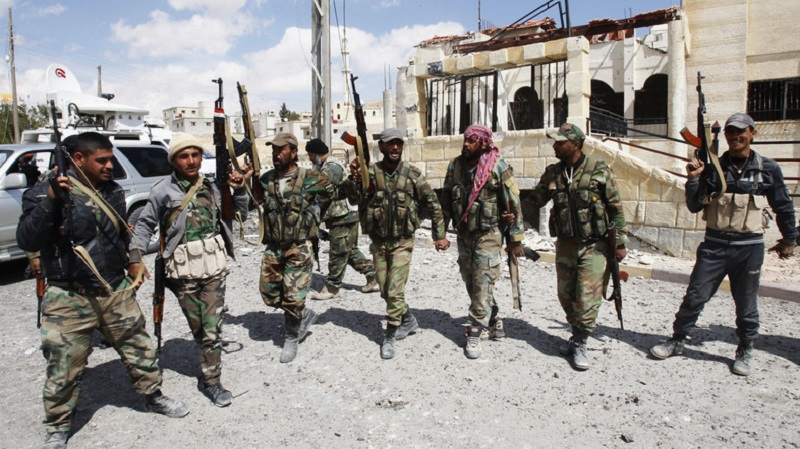The Syrian Arab Army (SAA) is preparing to launch a military operation against ISIS and Hay’at Tahrir al-Sham (formerly Jabhat al-Nusra, the Syrian branch of al-Qaeda) south of the Syrian capital, Damascus, the pro-government blog al-Masdar reported on December 27.
According to al-Masdar, the elite 42nd Brigade of the 4th Mechanized Division will be tasked with the operation. The source added that the 42nd brigade will deploy its units south of Damascus after finishing its operations in the western Ghouta region in the upcoming days.
The 42nd Brigade is commanded by Colonel Ghaith Dallah, and it’s well-known for clearing wide areas around Damascus from Hayat Tahrir al-Sham (HTS) including Khan Alsheh, Qaboun and Barda valley in 2016 and 2017.
Currently, ISIS controls the Yarmouk refugee camp south of Damascus. HTS and some Free Syrian Army (FSA) groups control the districts of Tadamon, Aqraba, Beit Sahm, Yalda and Babila east and west of the camp.
On January 6, a deal was reached to evacuate HTS fighters from the towns of Aqraba, Beit Sahm, Yalda and Babila south of Damascus. However, the deal failed because HTS foreign fighters had refused to leave the towns.
The SAA will likely win the battle not only because it got the upper hand in military terms, but also because HTS and ISIS have been fighting each other for months in the Yarmouk camp.





The Syrian Army seems bent on spreading its forces over a large number of fronts. It seems to me that they would achieve much more when they concentrated their attacks on one or two fronts and took a defensive position in all others.
Agreed. A concentrated effort on a minimum of two crucial fronts at a time seems like a better option. But the SAA seems to be taking a page out of the armed oppositions’ book on launching coordinated strikes at several fronts at a time, and has the manpower and material means to do it because the ISIS threat has been vastly reduced.
Attacking when you see a weak spot makes sense. Attacking at one point in order to force the enemy to divert forces from another front makes sense. But the rebels can no longer move troops between Idlib, Deir Ezzor, East Ghouta, Beit Jinn and South Damascus. So what is the point of attacking them at all those places at the same time?
Again, I agree with your points. I can only speculate on the current SAA strategy as being one of ‘attacking them everywhere because we can and to keep them guessing,’ even though its bewildering to you and me.
Yeah you know more about military strategy than the generals in the army. Good joke.
It is not a large number of fronts. At all. Where do you see all these fronts?
BTW, B. Jinn is long from being finished and the militants seem to have gained the upper hand in negotiations. They will not abandon this pocket, but are buying time to make new positions, dig tunnels and or use them to get weapons and support. Militant allies may be finalizing a plan on how to prevent collapse of the pocket & need time. We my expect a large scale attack on Fuah or air strikes on saa positions.
Militants were stuck in Mughr Al-Mir, and they were not able to withdraw due to exposure to fire. So they faked “negotiations” and bought themselves a safe corridor to move safely out of Mughr Al-Mir to Beit Jinn, with their weapons. That would have been nearly impossible under fire, as atgm’s and artillery would have wrecked havoc on their movements.
Damascus is showing great incompetence and weakness for allowing the militants to dictate terms and for allowing 4 to 5 days for them to recuperate.
Damas has been very consistent with how IT deals with pockets. Try negotiate, Cut pocket negotiate again, Crush Them.
Thats how it Will be for Beit jinn. Go get your shekels now boy
You fail to take into account the context:
Militants were cut off and stuck in Mughr Al-Mir without a safe way out to withdraw to Beit Jinn, as the only road to it was completely in the line of fire by saa.
It would have been a disaster for them to even try to pull back down that road. They were cut off from the rest of the pocket and out of supplies.
So, they outsmarted Damascus and faked a “surrender”, tricked the SAA to allow them to withdraw down that same road to Beit Jinn with their weapons and then procrastinated for 4 days; creating new positions, planting land mines, organizing defense and completing tunnels to the outside and/or using them to gather supplies and support.
Damascus allowed a bunch of defeated militants to dictate terms, giving them 4 to 5 days to “talk among themselves”. SAA troops will pay dearly for this catastrophe with their lives. Militants have enjoyed a massive boost in morale and announced today that they will not withdraw and will instead fight to the end.
The advance for saa will be exponentially more difficult now because the hills around B. Jinn prevent a LOS fire control on their positions. Militants communication channels are much shorter, their fighters are much more focused, and it will be very difficult to defeat them.
They did take that village without extra fighting though.